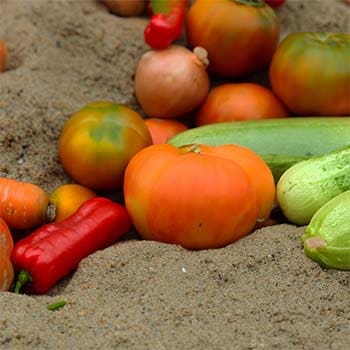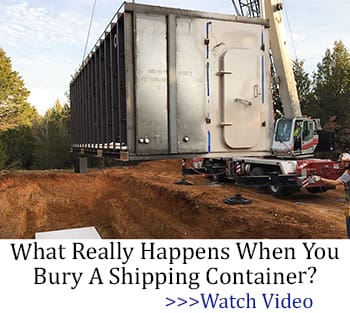Perhaps you’ve managed to produce a ton of carrots this year and you just don’t have the room to store them. Maybe your freezer fell through at the last moment or you just didn’t get the sales you expected. Hey, congratulations on such a bountiful harvest.
The problem is what you’re going to do to store it.
Today, we’ll look at sand storage methods for vegetables that are already clean and ready to go in your chilly winter dishes. Heads up, this works best with root vegetables and the types that tend to stick around much longer than celery or zucchini do. While sand can help lengthen their lifespans, it doesn’t do for them what it does for these strong roots. Let’s get started.
Sand? Really?
Sand! It’s what you can grow in and what you can store in! Isn’t it neat?
No, really, stop raising your brows. You can absolutely get a turtle sandbox (remember those?) full of sand and store nearly a ton of vegetables in it if you’re willing to keep an eye out for moisture issues and rotting or exposed vegetables.
Or you can do it by burying these roots and tuber in sandy ground, but I personally prefer to avoid that. This opens you up to pests and thieving little animals that are more than happy to swipe a few potatoes and call them their own.
Sand lasts because it wicks away moisture and allows vegetables to maintain their composure for a longer period than just air does. By drawing moisture and sugars out of them and into the sand itself, you could, theoretically, dry your vegetables over a long period (if there were few enough of them). This works in much the same way that salted meats were kept unrefrigerated throughout all but the modern history of humanity. With moisture withdrawn, the plant has less ability to rot. Sand, like salt, works well at doing this.
Can I Do This With Containers?
Theoretically, yes. You’ll need a good deal of holes in the container to permit air transfer throughout the sand and prevent molding, mildew, and essentially hot boiling your vegetables in their own juices over time. That, you see, is what we do not want to do.
The better thing to be able to do is to have a large, relatively shallow bin (I keep going back to those turtle sandboxes only because they were such a hallmark when we did this) that is easily able to hold a great amount of sand at once. If you only need to store a few vegetables, something as small as an under-the-bed tote is plenty to throw in a couple of pounds of potatoes, carrots, and onions each.
However, like planting, you’re going to want to avoid crowding. That leads to all sorts of problems and will completely ruin anything you want to see in spring that you’ve harvested in fall.
How Long…?
It depends on the condition of the vegetable, the exact type/variety, and a number of other matters. A home that runs at very low humidity and has low humidity sand, vegetables with perfectly intact skins, and sand with lots of ability to remit the humidity from within? That home will be able to store these root vegetables and tubers for a much longer time than a home in Florida that has a 50-ft tall bin full of sand that they’ve crammed full of onions and garlic.
Which, again, I am deeply encouraging you not to do. We’ve had this happen here, due to a misunderstanding with someone who was helping me prepare storage bins for the winter, and there was suddenly such an odd smell in my basement. When I tipped that onion soup out, it was so much worse than “strange”. Gag.
Long-Lasting Storage
The biggest problem with long-lasting non-chilled storage (ie; you aren’t using a fridge or a freezer to perform this) is that it does have a very finite date and that finite date may show up with little to no suggestion that it’s coming soon. This means that you may end up having a few bins go bad or spoil simply because you missed some bruising. Or that you have a parasite load that you’re unaware of and oops, now the bin is infested.
Related: 10 Foods Not To Store
After all, if you store your vegetables beyond their rot-by date for their vine or what have you, you’re going to give eggs and larvae a chance to continue evolving and perhaps even eat the fruits of your labor. It isn’t what you want to hear, but preservation may be a better idea than sand dry lotting (which is what this is officially called) long-term if the following happens:
- A plant you want to preserve is not in tip-top shape. This means free from blemishes and other damage and visible signs of infestation.
- You’re likely to have water leakage at your storage site. Whether in a basement or your attic (please don’t put this in your attic!), if you’re likely to have extremely high humidity or water leak issues, please go ahead and can your stash instead of trying to dry lot it.
- Your sand is not food-safe sand. While this can be more difficult to source, you absolutely need to be certain that the sand you want to use is safe for food purposes. The last thing that you want to do is make yourself sick with your storage methods, and it’s the last thing any of us wants for you and your family.
Ultimately, dry lotting (or sand storage) is a good way to protect your crops that you haven’t yet had a chance to get into jars, freezers, and so on and so forth. It’s an ancient way of keeping crops safe, but no longer one that I personally use due to some of the difficulties and failures I’ve had here in the southeastern USA.
Have you used sand storage? Tell us what you love or hate about it down in the comments and, as always, Happy Gardening!
You may also like:
Can You Plant a Grocery Store Cucumber?
How To Store Food Without Electricity That Can Last Up To A Year (Video)
Easy DIY Water Purification System For Under $20
How to Use the Whole Animal (Whether You Raise Your Own or Buy It)











What kind of “sand”, there are different kinds of sand? Can I use building sand? In NC we have mostly clay, do I use this clay to store Vegs? The picture shows what looks like beach sand or bleached sand.